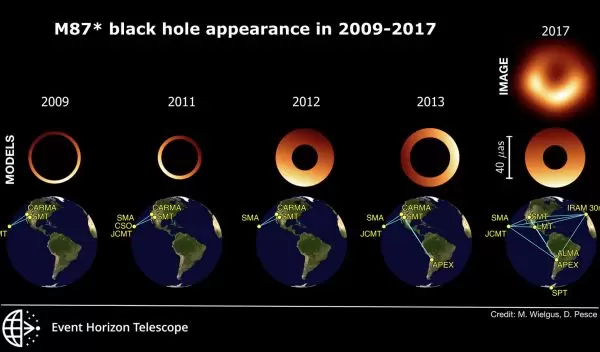
Wobbling shadow of the M87* black hole
In 2019, the Event Horizon Telescope Collaboration delivered the first image of a black hole, revealing M87* -- the supermassive object in the center of the M87 galaxy. The EHT team has now used the lessons learned last year to analyze the archival data sets from 2009-2013, some of them not published before. The analysis reveals the behavior of the black hole image across multiple years, indicating persistence of the crescent-like shadow feature, but also variation of its orientation -- the crescent appears to be wobbling. The full results appear in The Astrophysical Journal.
For two decades, the collaboration's largest commitment of funding has come from the U.S. National Science Foundation, which has directly funded more than $28 million in EHT research. This long-term commitment provided data archives going back to 2009, enabling the researchers to find behavioral trends for the crescent-shaped shadow, or event horizon, of the M87* black hole.
The EHT is a global array of telescopes performing synchronized observations. Together, the telescopes form a virtual Earth-sized radio dish, providing a uniquely high image resolution. "With the incredible angular resolution of the EHT we could observe a billiard game being played on the Moon and not lose track of the score!" said Maciek Wielgus, an astronomer at Center for Astrophysics | Harvard & Smithsonian, Black Hole Initiative Fellow, and lead author of the paper.
From 2009-2013, M87* was observed by early-EHT prototype arrays, with telescopes located at three geographical sites from 2009-2012, and four sites in 2013. In 2017, the EHT reached maturity with telescopes located at five distinct geographical sites across the globe.
"Last year we saw an image of the shadow of a black hole, consisting of a bright crescent formed by hot plasma swirling around M87*, and a dark central part, where we expect the event horizon of the black hole to be," said Wielgus. "But those results were based only on observations performed throughout a one-week window in April 2017, which is far too short to see a lot of changes. Based on last year's results we asked the following questions: is this crescent-like morphology consistent with the archival data? Would the archival data indicate a similar size and orientation of the crescent?"
Expanding the analysis to the 2009-2017 observations, scientists have shown that M87* adheres to theoretical expectations. The black hole's shadow diameter has remained consistent with the prediction of Einstein's theory of general relativity for a black hole of 6.5 billion solar masses.
But, while the crescent diameter remained consistent, the EHT team found that the data were hiding a surprise: The ring wobbles, and that means big news for scientists. For the first time, they can get a glimpse of the dynamical structure of the accretion flow so close to the black hole's event horizon, in extreme gravity conditions. Studying this region holds the key to understanding phenomena such as relativistic jet-launching and will allow scientists to formulate new tests of the theory of General Relativity.
"These early-EHT experiments provide us with a treasure trove of long-term observations that the current EHT, even with its remarkable imaging capability, cannot match," said Shep Doeleman, Founding Director, EHT. "When we first measured the size of M87* in 2009, we couldn't have foreseen that it would give us the first glimpse of black hole dynamics. If you want to see a black hole evolve over a decade, there is no substitute for having a decade of data."
Learn more about EHT, the M87 black hole photo and other NSF-supported research about black holes and view the full list of awards at nsf.gov.


